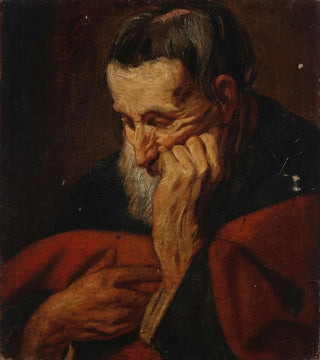Art print | Head of a bearded man, perhaps an apostle - Jacob Jordaens


View from behind

Frame (optional)
Captivating introduction
The Head of a bearded man, perhaps an apostle, an iconic work by Jacob Jordaens, immerses us in the rich and complex universe of 17th-century Flemish art. This piece, both mysterious and evocative, invites deep contemplation, revealing the subtleties of an era where art was intimately connected to spirituality and daily life. By examining this face imbued with wisdom and serenity, the viewer is transported to the heart of a reflection on the human condition, on the values of faith and devotion that transcend ages. The art print of this work not only allows appreciation of the artist's technical mastery but also captures the very essence of its message.
Style and uniqueness of the work
Jordaens' style is distinguished by striking expressiveness, where light and shadow dance harmoniously across the facial features. This work, although fragmentary, manages to capture the intensity of human emotions, revealing rare psychological depth. Warm colors, typical of the Flemish school, blend with subtly worked nuances, creating a striking effect of volume and realism. The texture of the skin, the detail of the beard, each element is carefully crafted, demonstrating exceptional craftsmanship. Focusing on the face of a bearded man, Jordaens succeeds in transcending simple representation to offer a reflection on identity, wisdom, and spirituality—universal themes that continue to resonate today.
The artist and his influence
Jacob Jordaens, one of the masters of Baroque painting, established himself as an essential figure in Flemish art. A pupil of Rubens, he developed a distinctive style combining realism and expressiveness. His work, often marked by religious and mythological themes, demonstrates a profound understanding of human nature. Jordaens influenced many artists of his time and beyond, notably through his ability to incorporate everyday life elements into sacred contexts. His innovative approach paved the way for a new way of viewing art, where the

Matte finish

View from behind

Frame (optional)
Captivating introduction
The Head of a bearded man, perhaps an apostle, an iconic work by Jacob Jordaens, immerses us in the rich and complex universe of 17th-century Flemish art. This piece, both mysterious and evocative, invites deep contemplation, revealing the subtleties of an era where art was intimately connected to spirituality and daily life. By examining this face imbued with wisdom and serenity, the viewer is transported to the heart of a reflection on the human condition, on the values of faith and devotion that transcend ages. The art print of this work not only allows appreciation of the artist's technical mastery but also captures the very essence of its message.
Style and uniqueness of the work
Jordaens' style is distinguished by striking expressiveness, where light and shadow dance harmoniously across the facial features. This work, although fragmentary, manages to capture the intensity of human emotions, revealing rare psychological depth. Warm colors, typical of the Flemish school, blend with subtly worked nuances, creating a striking effect of volume and realism. The texture of the skin, the detail of the beard, each element is carefully crafted, demonstrating exceptional craftsmanship. Focusing on the face of a bearded man, Jordaens succeeds in transcending simple representation to offer a reflection on identity, wisdom, and spirituality—universal themes that continue to resonate today.
The artist and his influence
Jacob Jordaens, one of the masters of Baroque painting, established himself as an essential figure in Flemish art. A pupil of Rubens, he developed a distinctive style combining realism and expressiveness. His work, often marked by religious and mythological themes, demonstrates a profound understanding of human nature. Jordaens influenced many artists of his time and beyond, notably through his ability to incorporate everyday life elements into sacred contexts. His innovative approach paved the way for a new way of viewing art, where the






